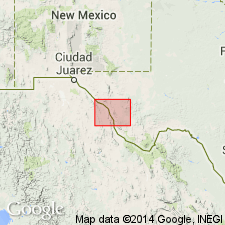
- Usage in publication:
-
- Bracks Rhyolite
- Modifications:
-
- Areal extent
- Geochronologic dating
- AAPG geologic province:
-
- Permian basin
Summary:
Bracks Rhyolite mapped as one of seven formations of Vieja Group in the Sierra Vieja area, Presidio and Jeff Davis Cos, west TX in Permian basin. Vieja Group is shown on the Correlation of Map Units as consisting of (ascending): Gill Breccia, Colmena Tuff, Buckshot Ignimbrite, Chambers Tuff, Bracks Rhyolite, Capote Mountain Tuff, and Mitchell Mesa Welded Tuff. Bracks is slightly porphyritic with rhombic anorthoclase phenocrysts as much as 3 mm in diameter, matrix alkalic feldspar, quartz, and mafic minerals; dark reddish brown to grayish olive. Thickness to 360 ft. K-Ar ages obtained of 36.5 +/-1.2 m.y. and 36.8 m.y. [Author states that correlation of volcanic rocks from area to area on Marfa sheet is uncertain--little attempt is made to correlate between areas. The rocks are described by area.] Of Oligocene age. Geologic map.
Source: GNU records (USGS DDS-6; Denver GNULEX).

- Usage in publication:
-
- Bracks Rhyolite
- Modifications:
-
- Geochronologic dating
- AAPG geologic province:
-
- Permian basin
Summary:
Pg. 14. Bracks Rhyolite of Vieja Group. Rhyolite sample from Gettysburg Peak quadrangle, Presidio County, southwestern Texas, yielded a K-Ar age of 37.9 +/-? Ma (alkali feldspar). Rhyolite sample (locality unknown) yielded a K-Ar age of 37.5 +/-1.2 Ma (alkali feldspar). Data from R.K. DeFord, 1958 (Texas Jour. Sci., v. 10, p. 1-37), J.F. Evernden and others, 1964 (Amer. Jour. Sci., v. 262, p. 145-198), and J.A. Wilson and others, 1968 (Amer. Jour. Sci., v. 266, p. 590-604); ages recalculated using decay constants of Steiger and Jager, 1977 (Earth Planet. Sci. Letters, v. 36, p. 359-362). [Age considered Eocene. Eocene-Oligocene boundary 36.6 (38-34) Ma (from Geologic Names Committee, USGS, 1983 ed. geol. time scale, with additions from N.J. Snelling, 1985, The Geol. Soc. Mem., no. 10).]
Source: Publication.
For more information, please contact Nancy Stamm, Geologic Names Committee Secretary.
Asterisk (*) indicates published by U.S. Geological Survey authors.
"No current usage" (†) implies that a name has been abandoned or has fallen into disuse. Former usage and, if known, replacement name given in parentheses ( ).
Slash (/) indicates name conflicts with nomenclatural guidelines (CSN, 1933; ACSN, 1961, 1970; NACSN, 1983, 2005, 2021). May be explained within brackets ([ ]).

